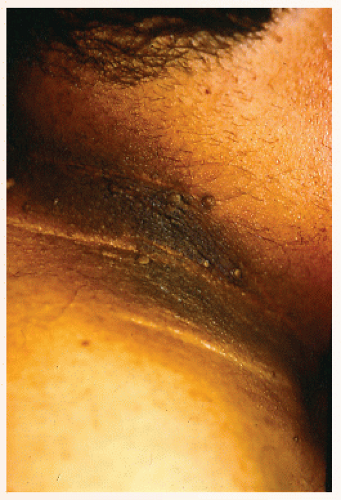Obesity and Dermatology
Noah S. Scheinfeld JD, MD
Obesity is defined as a weight or mass that exceeds the ideal weight or body mass index (BMI). A normal BMI is considered to be between 18.5 and 25. Overweight is defined by a BMI of 25 to 30. Obesity class I is defined by a BMI of 30 to 35, obesity class II is a BMI of 35 to 40, and obesity class III is defined as a BMI of 40 and above. The excess mass associated with obesity impacts and is related to several body systems that include (1) the cutaneous system and its subsystems (a) the epidermal system, (b) the follicular system, and (c) the adipose system; (2) the cardiovascular system; (3) the endocrine system; and (4) the nervous system. This review will assess the impact of obesity based on its effects on these systems.
The Cutaneous System
Obesity Leads to Alterations of Body Shape
Obesity alters foot shape and induces plantar hyperkeratosis, which should be considered a cutaneous stigma of morbid obesity. Weight can generate physical changes in the foot structure of children with lower footprint angles and a higher Chippaux-Smirak index. Obesity increases forefoot width and causes higher plantar pressure during standing and walking in both children and adults.
Obesity Leads to Alterations of the Texture of the Skin
The main alterations to the texture of the skin involve the development of acanthosis nigricans, skin tags, striae, lymphedema, and stasis dermatitis. The changes in skin texture related to obesity can be due to etiologies other than obesity but are more common in the obese as compared with the general population.
Acanthosis Nigricans
Acanthosis nigricans (Fig. 43-1) is a cutaneous condition affecting localized areas of the skin (especially intertiginous areas in the axillary, inguinal and inframmary areas) under skin tags and then may disappear after pregnancy. It is commonly described as manifesting as brown velvety plaques on the skin. Other causes and relationships of acanthosis nigricans include malignancy and diabetes. Acanthosis nigricans can be associated with rare genetic syndromes.
Hyperpigmentation and apparent thickening of the skin correlate with histologic papillomatosis, and the apparent darkening is due to hyperkeratosis. The mechanistic basis of acanthosis nigricans includes (1) high levels of circulating insulin, (2) insulin resistance in keratinocytes, (3) stimulation of insulin-like growth factor (IGF) receptors in keratinocytes by insulin, and (4) IGF receptor induction of keratinocyte proliferation.
Skin Tags
Skin tags or acrochordons are common in patients who are obese. It is likely that this is due in large part to the association of skin tags with diabetes. Other conditions associated with skin tags include Birt-Hogg-Dube syndrome. Skin tags can arise during pregnancy but then disappear afterward. Some have stated that independent of diabetes, skin tags are not associated with obesity.
Striae
The tension of stretched skin results in the development of striae. While many patients who are obese have striae, not all patients who have striae are obese. Pregnancy and the growth spurt of adolescence can result in striae. The striae of pregnancy and obesity are usually permanent, while the striae related to growth spurts are sometimes transient.
The striae of obesity arise along cleavage lines perpendicular to the direction of greatest tension in areas with the most adipose tissue—the breasts, buttocks and lateral
abdomen, and thighs. Striae are characterized by linear, smooth bands of atrophic-appearing skin that are sometimes initially erythematous, then purple, and finally white and depressed. Striae seem to be a type of dermal scarring with an aberrant healing response and replacement of collagen. Histologically, striae are marked by densely packed areas of thin, eosinophilic, collagen bundles, horizontal to the surface in a parallel fashion and lacking rete pegs, adnexal structures, and normal dermal undulations. In addition, hair follicles and other appendages are absent in striae.
abdomen, and thighs. Striae are characterized by linear, smooth bands of atrophic-appearing skin that are sometimes initially erythematous, then purple, and finally white and depressed. Striae seem to be a type of dermal scarring with an aberrant healing response and replacement of collagen. Histologically, striae are marked by densely packed areas of thin, eosinophilic, collagen bundles, horizontal to the surface in a parallel fashion and lacking rete pegs, adnexal structures, and normal dermal undulations. In addition, hair follicles and other appendages are absent in striae.
SAUER’S NOTES
Obesity is occurring in the United States in epidemic proportions and all fields of medicine are striving to reverse this trend. Emphasizing weight reduction is the job of all physicians, and the dermatologist is in the unique position of emphasizing the most deforming and easily observed problems associated with this most common eating disorder.
Lymphedema
Lymphedema manifests with pebbly skin on the legs. Due to the changes in circulation resulting in changes to the texture of the skin, lymphedema will be considered here and in the section on the cardiovascular system. Lymphedema is also referred to as elephantiasis nostra verrucosa (ENV). ENV and lymphedema can also occur due to the presence of parasites as is the case in filariasis, which obstructs the lymphatic vessels.
Lymphedema most commonly manifests on the shins and results from poor lymphatic return. Its etiology involves lymph accumulation and dilation of lymphatics. The initial manifestation is soft, pitting edema. The process can be furthered by recurrent bacterial lymphangitis and obstruction of the major lymphatic vessels. There can be hyperkeratosis and papillomas in the plaques of lymphedema.










